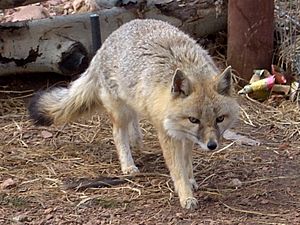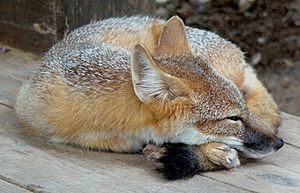Swift fox facts for kids
Quick facts for kids Swift fox |
|
|---|---|
 |
|
| Swift fox at Colorado Wolf and Wildlife Rescue Center | |
| Conservation status | |
| Scientific classification | |
| Genus: |
Vulpes
|
| Species: |
velox
|
 |
|
| Swift fox range | |
| Synonyms | |
|
|
The swift fox (Vulpes velox) is a small light orange-tan fox around the size of a domestic cat found in the western grasslands of North America, such as Montana, Colorado, New Mexico, Kansas, Oklahoma and Texas. It also lives in southern Manitoba, Saskatchewan and Alberta in Canada, where it was previously extirpated.
Contents
Description
The swift fox has a dark, grayish, tan coloration that extends to a yellowish tan color across its sides and legs. The throat, chest, and belly range from pale yellow to white in color. Its tail is black-tipped, and it has black patches on its muzzle. Its ears are noticeably large. It is about 12 inches (30 cm) in height, and 31 inches (79 cm) long, measuring from the head to the tip of the tail, or about the size of a domestic cat. Its weight ranges from around five to seven pounds. Males and females are similar in appearance, although males are slightly larger.
Distribution and habitat
The swift fox lives in short-grass prairies and western grassland. They form their dens in sandy soil on open prairies, in plowed fields, or along fences. It is native to the Great Plains region of North America, and its range extends north to the southern Alberta and Saskatchewan, Canada, and south to Texas. It reaches from western Iowa to Colorado, Kansas, Wyoming, Nebraska, and Montana.
Behavior
The swift fox is primarily nocturnal, spending only evenings and nighttime above ground in the summer. Daytime activities are usually confined to the den, but it has been known to spend the warm midday period above ground during the winter.
The swift fox is more heavily dependent on its den than most North American canids, using them as shelter from predators. These dens are usually burrows that are two to four meters in length.
It has been known to run very fast, at speeds of over 50 km/h (30 mph) or up to 60 km/h (40 mph).
Predators
The coyote is the swift fox's main predator, but often chooses not to consume the swift fox. Other predators include the badger, golden eagle, and bobcat. It is also vulnerable to trapping and poisoning, as well as death on highways.
Reproduction
It breeds once annually, from late December to March, depending on the geographic region.
The male swift fox matures and may mate at one year, while the female usually waits until her second year before breeding. Adults live in pairs, and although some individuals mate for life, others choose different partners each year. Gestation takes around 51 days, and four to five kits are born.
Pups are born in the den and typically remain there for approximately one month. A newborn pup's eyes and ears remain closed for ten to fifteen days, leaving it dependent on the mother for food and protection during this time. It is usually weaned around six or seven weeks old and remains with its parents until fall.
Diet
Like most foxes, the swift fox is an omnivore. Rabbits, mice, ground squirrels, birds, insects and lizards are staples. Grasses and fruits round out its diet. However, like any efficient forager, the swift fox takes advantage of seasonal foods. During the summer, adults eat large amounts of insects, including beetles and grasshoppers, and feed their young with larger prey items. Deer and other carrion killed by other animals may also be important food sources.
Conservation status
The swift fox was once a severely endangered species, due to predator control programs in the 1930s that were aimed mostly at the gray wolf and the coyote. The species was extirpated from Canada by 1938, but a reintroduction program started in 1983 has been successful in establishing small populations in southeast Alberta and southwest Saskatchewan.
In May 1999, the Species at Risk Act listed the swift fox as an endangered species in Canada, giving the species further protection for growth. A small, but stable and growing population continues to live freely in the southeastern regions of Alberta, and southwestern regions of Saskatchewan.
Canada's national recovery strategy plan was revised in 2008 by the National Swift Fox Recovery Team, with projections of a long-term goal by 2026, "to restore a self-sustaining swift fox population of 1,000 or more mature, reproducing foxes that does not experience greater than a 30% population reduction in any 10-year period".
In addition to its populations in Canada, there are also swift fox populations in the United States, ranging from South Dakota to Texas. Populations in the United States are stable in the central part of its range, and it is not considered endangered in the United States. The IUCN Red List characterizes it as of Least Concern.
Interesting facts about the swift fox
- It is closely related to the kit fox.
- The swift fox may occupy up to thirteen dens in one year, moving because prey is scarce or because skin parasites build up inside the den.
- Sometimes it makes other burrows from other bigger animals, even though it is completely capable of digging one on its own.
- Recent research has shown that social organization in the swift fox is unusual among canids, since it is based on the females. Females maintain territories at all times, but males emigrate if the resident female is killed or removed.
- In the wild, its lifespan is 3 to 6 years, but may live up to 14 years in captivity.
- Exact population numbers of the swift fox are unknown, but it is known that they currently inhabit only 40% of their historic range.
See also
 In Spanish: Zorro veloz para niños
In Spanish: Zorro veloz para niños



